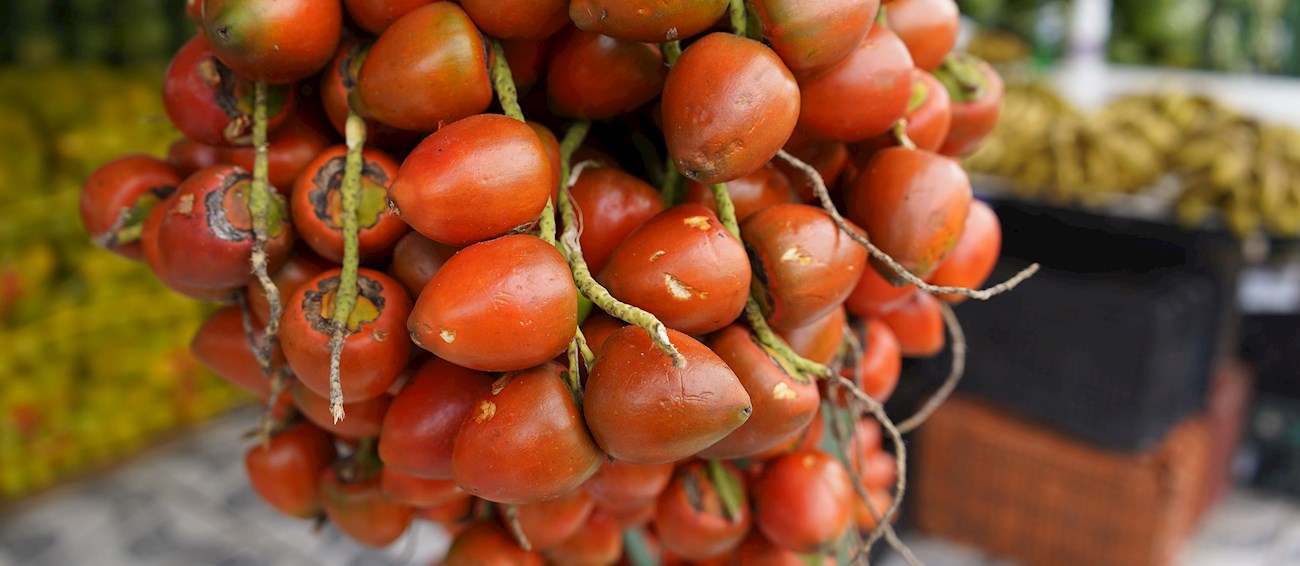Tamarillo is a small shrub or tree that’s native to the Andean regions of Colombia, Ecuador, Peru, Bolivia, and Chile. The small egg-shaped fruits are succulent and have a slightly sweet to subacid flavor of the pulp. The flavors are often described as similar to kiwi and underripe tomatoes.
Tamarillo fruits are used in numerous sweet and savory dishes, beverages, salads, dips, spreads, chutneys, pickles, jams, and sweet or savory sauces. In Ecuador, cooks make a tamarillo sauce by mixing the fruits with garlic, onions, salt, hot peppers, and spices such as coriander.
Peach palm fruit is the edible fruit of the peach palm tree (lat. Bactris gasipaes). This tropical palm is cultivated for both its fruit and its heart of palm, making it an important crop in various parts of Central and South America.
The fruit itself is small, typically about the size of a large olive or small peach, and has a hard, thick skin ranging in color from yellow to orange to red when ripe. Nutritionally, peach palm fruit is rich in carbohydrates, dietary fiber, vitamins A and C, and contains some protein.
Mountain papaya is an evergreen softwood tree that’s native to the Andes from southern Colombia to central Chile, but it’s also cultivated in subtropical and cool mountain climates of Southeast Asia and Africa. The tree produces fruits that have soft flesh with many round brown seeds.
When fully ripe, the fruits are slightly tart and acidic with an intense aroma. They’re usually enjoyed fresh or sprinkled with sugar. The fruits are also used to produce jellies and marmalades. Mountain papaya can be stewed and served as dessert, while chunks of the fruit are sometimes preserved in syrup.
Camu camu (lat. Myrciaria dubia) is a small, sour fruit native to the Amazon rainforest, particularly in regions of Peru and Brazil. It grows on a bushy tree that thrives in the swampy or flooded areas of the rainforest.
The fruit is roughly cherry-sized and has a purplish-red skin with a yellow pulp, bearing a resemblance to a large grape or a small plum. Camu camu is best known for its extraordinarily high vitamin C content, often cited as one of the richest natural sources of vitamin C in the world, surpassing many citrus fruits.
Cocona is a tropical fruit growing in South America and the Andean region. It is characterized by its thin, yet tough skin, and a tart, fruity flavor. Cocona's flesh is very similar to that of a tomato, and it is often used in the preparation of sauces, juices, ice creams, and desserts.
The fruit is very rich in vitamin B5 and iron, making it a healthy, yet flavorful and versatile ingredient for numerous culinary uses.
Native to South America, aguaymanto (Physalis peruviana), called topotopo in the indigenous Quechua language, is a perennial herb that produces edible, round, yellowish-orange berries which have a soft, succulent flesh characterized by a pleasant, tangy sweetness.
Mainly distributed in Peru, Chile, Ecuador, Colombia and the Argentine provinces of Salta and Jujuy, the plant is typically gathered from the wild, and it is closely related to tomatoes, eggplants, and potatoes. The indigenous populations, including the Incas, have long consumed the fruits of the aguaymanto plant.
TasteAtlas food rankings are based on the ratings of the TasteAtlas audience, with a series of mechanisms that recognize real users and that ignore bot, nationalist or local patriotic ratings, and give additional value to the ratings of users that the system recognizes as knowledgeable. TasteAtlas Rankings should not be seen as the final global conclusion about food. Their purpose is to promote excellent local foods, instill pride in traditional dishes, and arouse curiosity about dishes you haven’t tried.





